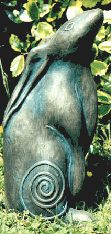 Following is an excerpt from blogger Mark Farley’s September 2007 response to author and celebrity chef Clarissa Dickson Wright’s support of the “sport” of hare coursing.
Following is an excerpt from blogger Mark Farley’s September 2007 response to author and celebrity chef Clarissa Dickson Wright’s support of the “sport” of hare coursing.___________________________________
Hare coursing is an act, banned in 2004, involving dogs racing against each other in an attempt to catch hare. A practice (until quite recently) that had it’s own league, events and championship, the Waterloo Cup.. . . With Clarissa’s new book, Spilling the Beans . . . she may have done her case no good by not only being equally in support of blood sports but in particular her passion for coursing, in particular. Some of the things she has said in the book may not go in her favour, as she gives the impression that whatever “psycho” Tony Blair puts into law, she is going to whatever the hell she likes regardless.First of all she tells us that she fell in love with coursing (“a great rural and social resource”) around ten years ago and was proud and steadforth (Sgt Major, Sir!) when she was asked to become a member and outspoken voice for the National Coursing Club, who still house a very pointless website quoting a roman called Arrian who said, “The true sportsman does not take out his dog to destroy the hares, but for the sake of the course and the contest between the dogs and the hares, and is glad if the hare escapes,” like it means anything and is going to help them in any way.Then she waxes lyrically about the history of the practice stating that the “sport” was depicted on early Greek pottery and that Romans introduced the brown hare into England for the purpose of coursing.Clarissa, that doesn’t make it right. An educated person like you must realise that one thing history or a passion for has taught us that is that in the past . . . we have been complete arseholes. “The aim is not to kill the hare,” she says “but to test the respective abilities of two greyhounds in pursuit of it. The points are given for the first dog to pull ahead of the other. No points are awarded for a kill.”Thank you for the lesson in the illegal sport, my dear. But that’s not the point. The killing does happen, which is why it’s banned. It’s wrong to take enjoyment in taking the life of something for the sake of pastime. Sure, I like to eat meat just like the next man, but I like to try and be ethical about how it suffered instead of standing in a field with a jug of Pimms, gorging on deer pate and guffawing with glee at the splendour of the achievement of one animal’s fight over another much lesser and smaller than thee.“Opponents of the sport say that the hare is terrified but I have seen hares peacefully grazing on the coursing field a few hours after the event.”I have seen them take tea, indulge in some light snacks, perhaps a small pork and egg pie. They canter aloofly and bound gracefully, chuckling Wodehouse-like witticisms between them without a care in the world. Look here, I even have a signed affidavit from one such creature, saying that there was no mental distress whatsoever.My favourite part of her argument is that farmers will shoot the hares regardless if they are not allowed to course, whereas if they are, they will be tolerated for the sake of the event, even if they are constantly eating away at their vegetation.That’s right. Hare coursing in their best interests. So basically, your conclusion is . . . fuck them. They’re gonna die anyway, yeah? Spoken like a true product of privilege: vile, gluttonous and cruel. I raise my hip flask and salute you!Image 1: “Greyhounds Coursing a Hare” by Dean Wolstenholme.
“The aim is not to kill the hare,” she says “but to test the respective abilities of two greyhounds in pursuit of it. The points are given for the first dog to pull ahead of the other. No points are awarded for a kill.”Thank you for the lesson in the illegal sport, my dear. But that’s not the point. The killing does happen, which is why it’s banned. It’s wrong to take enjoyment in taking the life of something for the sake of pastime. Sure, I like to eat meat just like the next man, but I like to try and be ethical about how it suffered instead of standing in a field with a jug of Pimms, gorging on deer pate and guffawing with glee at the splendour of the achievement of one animal’s fight over another much lesser and smaller than thee.“Opponents of the sport say that the hare is terrified but I have seen hares peacefully grazing on the coursing field a few hours after the event.”I have seen them take tea, indulge in some light snacks, perhaps a small pork and egg pie. They canter aloofly and bound gracefully, chuckling Wodehouse-like witticisms between them without a care in the world. Look here, I even have a signed affidavit from one such creature, saying that there was no mental distress whatsoever.My favourite part of her argument is that farmers will shoot the hares regardless if they are not allowed to course, whereas if they are, they will be tolerated for the sake of the event, even if they are constantly eating away at their vegetation.That’s right. Hare coursing in their best interests. So basically, your conclusion is . . . fuck them. They’re gonna die anyway, yeah? Spoken like a true product of privilege: vile, gluttonous and cruel. I raise my hip flask and salute you!Image 1: “Greyhounds Coursing a Hare” by Dean Wolstenholme.
Image 2: Photographer unknown.































